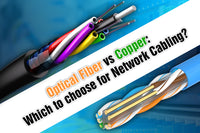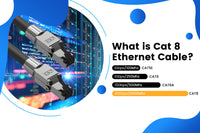Businesses and individuals have increasingly higher demand for high-speed data transmission. They may meet the challenge of choosing between Cat8 and fiber optic cables as both of these two cables are designed for high-speed network transmission. Cat8 Ethernet cables are known for their improved speed and frequency capabilities, while fiber optic cables are known for their long-distance transmission and resistance to electromagnetic interference. So how do you choose between Cat8 and fiber optic cables? This blog will help you choose the best cable for you.
What is Cat8?
Cat8 is the newest innovation in copper cabling technology, which is designed to meet the increasing demands of fast network speed. Cat8 supports a bandwidth of up to 2000 MHz and it can achieve a data rate of 10 G within 100 meters (330 feet) and 25 G to 40 G within 30 meters (98 feet). Cat8 cables usually feature shielded foiled twisted pairs and 4-pair braid shielding to reduce cross-talk and external interference. These cables also have thicker copper wires than Cat6a and Cat6 cables, and you should pair them with Cat8 RJ45 connectors.
Cat8 is commonly used in high-performance environments, such as data centers, server rooms, and high-performance computing (HPC) networks. But it is not suitable for long runs in large buildings and campuses.
What is Fiber Optic?
Fiber optic cables are primarily made of glass and plastic. Each fiber is thin and tiny but can transmit high-speed data as light pulses. The optical cable is mainly composed of five layers: core, cladding, coating, strengthening fibers, and cable jacket. The fiber core is protected by the cladding layer to ensure the total internal reflection.
Fiber optic cables play an important role in transmitting data over long distances. Single-mode and multi-mode are two types of fiber optic cables. Multi-mode fiber has a larger core that carries more bandwidth but loses more signal over long distances, while single-mode fiber sends light directly to the fiber by using lasers, suitable for long-distance transmission. OM3 and OM4 are two main types of multi-mode fibers used in 40G networks, which provide adequate service for most enterprises.
Fiber optic cables can support transmission speeds of 100 Gbps and beyond, making them perfect for fields like telecommunications, medicine, military, high-performance computing, and other fields.
Advantages of Fiber Optic Cables
- High-speed Transmission: Fiber optic cables can transmit data at a light-like speed, ensuring rapid and reliable data transfer with minimal signal attenuation.
- Long-distance Coverage: Fiber optic cables have no limit of 100-meter running length, so they can cover longer distances than copper cables and are often used in network installations at an extra-long distance.
- Immunity to Interference: Fiber optic cables are not susceptible to electromagnetic interference (EMI) and radio frequency interference (RFI).
- High-density Installation: Their small size and light weight make them ideal for efficient installation and maintenance in space-limited and high-density data centers.
Cat 8 vs. Fiber Optic: What Are the Differences?
Cat8 Ethernet cables and fiber optic cables are both designed to deliver fast data speed, but they have different features and are used for different purposes:
-
Construction: Cat8 cables mainly consist of four twisted pairs of copper wires, with each pair shielded. This shielded foil twisted pair (S/FTP) construction can effectively prevent crosstalk, EMI, and RFI.
Fiber optic cables mainly consist of fiber core, cladding, coating, strengthening fibers, and cable jackets. Each strand of glass or plastic fibers is coated in a cladding layer.

- Data Rate and Transmission Distance: Cat8 cables can provide a data transfer speed of 25 Gbps or 40 Gbps and bandwidth of up to 2 GHz. The maximum running length of Cat8 cables is 100 meters (328 feet). In contrast, fiber optic cables, such as SMF (single-mode fiber) or MMF (multi-mode fiber) can provide a maximum data rate of 100 Gbps or higher. In addition, it has a longer transmission distance than Cat8 cables.
- Signal Interference: Cat8 cables are made of copper wires, which are more susceptible to electromagnetic interference (EMI) and radio frequency interference (RFI). While Cat8 cables are equipped with foil or braid, their performance may still be affected in environments with high electromagnetic activities. Fiber optic cables use glass or plastic fibers to transmit optical signals and they can ensure stable performance in electrically noisy environments..
- Durability: Cat8 copper cables can be more robust than fiber optic cables. They can withstand more physical stress. Fiber optic cables are fragile due to the use of glass or plastic fibers and they require careful operation during the process of installation.
- Cost and Installation: Cat8 is easier to install, especially for those environments equipped with copper-based networking infrastructure. It is a cost-effective solution for short-distance high-speed network installation especially for 40G applications. Fiber optic cables require higher initial costs as they use more devices such as fiber transceivers, splicing tools, and conversion boxes, but they offer a future-proofing solution to 100G to 400G applications.
|
Fiber Optic |
Cat 8 |
|
|
Speed |
Up to 100 Gbps or Higher |
Up to 25 Gbps or 40 Gbps |
|
Bandwidth |
Unlimited for real uses |
2 GHz |
|
Maximum Running Length |
Up to 6.2 miles ( 32736 feet) or longer |
100 meters (328 feet) |
|
Signal Integrity |
Immune to Interference |
Susceptible to Interference |
|
Installation Cost |
Higher initially but future-proofing |
Cost-effective |
|
PoE |
Not Supported |
Supported |
|
Durability |
Less |
More |
|
Use Cases |
Backbone connections in telecom rooms; long-distance enterprise network connections
|
Shorter-distance connections in data centers |
Cat8 vs Fiber Optic: Which to Choose?
Now that you have already understood the distinctive performance of Cat8 and fiber optic cables. The decision on which to choose depends on your specific network requirements:
Cat8 Ethernet cables are generally suitable for short-distance, high-speed connections. They are often used to connect hardware devices such as switches, and storage devices in the same room of data centers and server rooms. Cat8 cables are also suitable for home or small enterprise networks. For home users, Cat8 provides sufficient bandwidth and low latency for applications such as multimedia, HD streaming, and high-performance gaming. But Cat8 cables are often excessive for most general individual users.
Fiber optic cables ensure reliable long-distance communication for telecom rooms, telecommunication companies, and internet service providers (ISPs). They are less susceptible to EMI interference, making them an ideal medium for FTTx applications such as FTTH, FTTB, and FTTC and environments like residential and commercial buildings.
In the End
Cat8 and fiber optic are two of the most advanced solutions for achieving high-speed network connections. Cat8 cables are a cost-effective choice for short-distance, high-speed applications; while fiber optic cables are known for their ability to deliver ultra-high speed and long-distance transmission without signal degradation. Generally, Cat8 is a cost-effective solution, but fiber optic is a future-proofing option for your network expansion and the final choice still depends on your specific needs varying in different network environments.
For more information on this topic, you can keep up on our blogs. While VCELINK offers general and basic information for our customers and other visitors to the website, it’s not professional advice.



Be the first one to comment.
Leave a comment